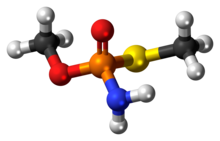
Back Metamidafós Catalan Methamidophos German Metamidofos Spanish Méthamidophos French メタミドホス Japanese Methamidofos Dutch Metamidofós Portuguese Metamidofos Serbo-Croatian Metamidofos Serbian 甲胺磷 Chinese

| |

| |
| Names | |
|---|---|
| Preferred IUPAC name
O,S-Dimethyl phosphoramidothioate | |
| Identifiers | |
3D model (JSmol)
|
|
| 1098870 | |
| ChEBI | |
| ChEMBL | |
| ChemSpider | |
| ECHA InfoCard | 100.030.538 |
| EC Number |
|
| KEGG | |
PubChem CID
|
|
| RTECS number |
|
| UNII | |
| UN number | 3018 2783 |
CompTox Dashboard (EPA)
|
|
| |
| |
| Properties | |
| C2H8NO2PS | |
| Molar mass | 141.1 g/mol |
| Density | 1.31 g/cm3 |
| Melting point | 44.5 °C (112.1 °F; 317.6 K) |
| Boiling point | thermally unstable |
| Hazards | |
| GHS labelling: | |
 
| |
| Danger | |
| H300, H311, H330, H400 | |
| P260, P264, P270, P271, P273, P280, P284, P301+P310, P302+P352, P304+P340, P310, P312, P320, P321, P322, P330, P361, P363, P391, P403+P233, P405, P501 | |
Except where otherwise noted, data are given for materials in their standard state (at 25 °C [77 °F], 100 kPa).
| |
Methamidophos, trade name "Monitor," is an organophosphate insecticide.
Crops grown with the use of methamidophos include potatoes[1] and some Latin American rice.[2] Many nations have used methamidophos on crops, including developed nations such as Spain, United States, Japan, and Australia. Due to its toxicity, the use of pesticides that contain methamidophos is currently being phased out in Brazil. In 2009, all uses in the United States were voluntarily canceled.[3]
- ^ "methamidophos (Monitor) Page 1". Archived from the original on 2000-03-03.
- ^ Did Your Shopping List Kill A Songbird? Bridget Stutchbury, New York Times March 30, 2008
- ^ "Federal Register / Vol. 74, No. 183 / Wednesday, September 23, 2009 / Notices" (PDF). US EPA. 23 September 2009. Retrieved 13 February 2018.
© MMXXIII Rich X Search. We shall prevail. All rights reserved. Rich X Search